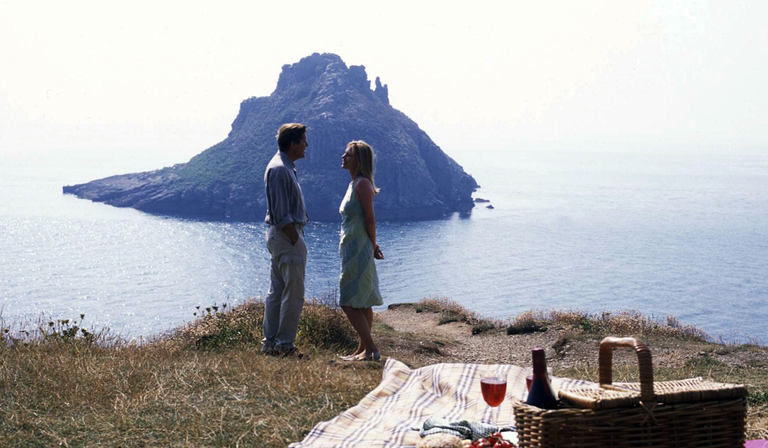In winter, when the tourists are gone, the locals have Cornwall to themselves. The days are shorter, and storms often whip foaming seawater over the clifftops. Tour guide Steve Dawes usually sells cheese at regional markets at this time of year, but on a bright blue November day he stands behind a granite church overlooking the mouth of the River Hayle. The reason he brings German people, like me, here is not the picture-postcard scenery. It’s a love story.
In 1946, Rosamunde Scott, who was to become a famous novelist many years later, married the veteran Graham Pilcher in her hometown of Lelant. Pilcher, who died in 2019 at the age of 94, inspired what is perhaps an even bigger romance: the Germans’ love affair with Cornwall.
Germans are the largest group of foreign tourists to Cornwall, with six-figure numbers visiting each year. Rosamunde Pilcher, who was described by family members as not particularly emotional herself, has become synonymous in Germany with schmaltzy storylines promising happy-ever-afters in the wildly romantic Cornish landscape. Her work has romanticised the German image of England.
Pilcher had been writing love stories since she was a young woman, initially under the pseudonym Jane Fraser. However, it was not until 1987, when she was already an older woman, that her family saga The Shell Seekers was published and became a huge international success.
“Reading should be like a holiday,” the author once told a German newspaper—an escape into another world or, in her case, a nostalgic memory of Cornwall, which she left to move to Scotland with her husband.
“In a way, the series has been a billboard, Sunday after Sunday after Sunday,” says Malcolm Bell, a director of Visit Cornwall. Pilcher’s novels and short stories have been turned into 180 German TV productions; the ZDF channel showed around 30 Pilcher reruns and two new productions in 2024 alone, with more being shot in Cornwall this year. The films are so popular that Germans, often affluent and over 50, want to see Cornwall in real life—to the extent that Pilcher was awarded a British Tourism Award in 2002.
Dawes, the tour guide, is more interested in the bronze age than cheesy romance novels—but Pilcher has become an inescapable part of his job. “When I have a group with one or two Germans, Rosamunde Pilcher always comes into the story,” he says.
Dawes drives us in his van up a gravel path to an Elizabethan manor house. The sea shimmers in the background, a silver Bentley rests on the drive and ivy grows up to the battlements, although, at the time of year we’re here, the leaves have long fallen off the creeping stems. The Prideaux-Brunes family has lived here, on the fringes of the seaside town of Padstow, for more than 425 years. More than a dozen Pilcher films have been made on the estate, some of which feature the current owner, Peter Prideaux-Brune, as a chauffeur or a gin taster.
In summer, German-speaking guides take high numbers of visitors through the rooms: the dark wood-panelled dining room; the library, where the sun shines through stained-glass windows onto leather-bound books. Prideaux is now quiet. The family have the 81 rooms to themselves. Is it nice to be alone for a change? “Very,” says a member of the family, sitting in an armchair by the fire in a study, two black labradors beside her. In the large drawing room, a photograph recalls one of Pilcher’s visits to the house.
The film producer Michael Smeaton’s discovery of Pilcher had nothing to do with the Scottish family connections his name connotes. A colleague had heard of Pilcher after The Shell Seekers became a hit, selling more than 10m copies around the world, and tipped him off. Since then, he has made her name better known in Germany today than in her own country. In 1993, the first film for the national broadcaster ZDF, Stürmische Begegnung (of the novel The Day of the Storm) was watched by almost nine million people. They immediately commissioned 10 more.
Recently aired Pilcher films for German television have titles such as Where Your Heart Lives, In Love with a Butler, Roses in the Storm and Coast of Dreams. The ingredients for success have remained the same through the decades: “It always has to be girl meets boy or boy meets girl,” Smeaton explains; there must be a rival, and the audience should quickly suspect who will go on to win the heroine’s heart. The road to happiness may be paved with malice, intrigue and envy, but it does always have to reach that happy destination. “If they want the thrill, they can watch Tatort,” Smeaton says, in reference to Germany’s long-running Sunday night police show—and often a rival for the highest viewer ratings.
‘We show an England that no longer exists like this. Even in Cornwall, people don’t walk around in tweed jackets and rubber boots...’
And, of course, the story is always set in upper-middle-class Cornwall. You see mostly German actors in woollen jumpers and flat caps on lonely strolls through the Cornish landscape or ensconced in cosy domesticity. “We show an England that no longer exists like this,” explains Smeaton. Even in Cornwall, people don’t walk around in tweed jackets and rubber boots, and they don’t shoot birds or go fishing every weekend, he says. “We give the viewer a picture of England as they want it to be.” This means that, even when the films are set in the modern age, the beautiful views of the seas and cliffs and hills are not disturbed by lampposts or motorways. The viewer should be able to tell from a single glance at the television set that this is a Pilcher story.
Pilcher herself liked the films, says Smeaton, who visited her in Scotland numerous times, with the pair becoming close friends. He describes her as a pragmatic woman, “very funny and down to earth”, who nevertheless enjoyed her stardom when coming to Germany for award ceremonies or readings.
Dawes is glad the films are saturating German television with images of Cornwall’s coast and cliffs, its flowering hedges, cream teas, white cottages and fishing villages. Everything that the series leaves out—the power of the unyielding sea, the tin mining, the history of smuggling, the Cornish language and sense of independence, the remnants of the bronze age—he can bring to life for his guests for the first time, trying to make his tour fun and educational. It is a dream job for him: “I take people who are genuinely interested to learn about the best place in the world, which is also my home,” he says. The pay isn’t bad either, he adds, and he gets to meet people from all over the world: “So what’s not to love?”
Cornwall needs tourism. One in three households is wholly or partly dependent on the visitor economy, says Bell of Visit Cornwall. Along with farming and fishing, it is one of the foundations of Cornwall’s economy. “Tourism from Germany has also stimulated the market for other nationalities,” Bell adds. And if a lot of foreign tourists come, it is a “seal of approval” for domestic tourists, too—if so many people come from so far away, a place really must be special.
Most Germans visit by coach, but Bell observes a growing number of independent travellers; people in their forties who know the scenery from TV but are not necessarily Pilcher fans. They like to visit the coast, flocking to small jewellery shops and potteries and staying in guesthouses and small hotels, which puts more money in local pockets.
The last stop of Dawes’s tour is St Michael’s Mount, just off the south-western tip of the county. A ferry takes people across the water to this tidal island and its picturesque castle, but at low tide tourists can instead take themselves along a narrow causeway. During our visit, we see a couple making that walk towards the sunset, holding hands as the beach is bathed in golden light. It is the perfect Rosamunde Pilcher moment.













